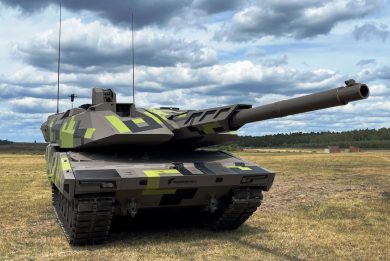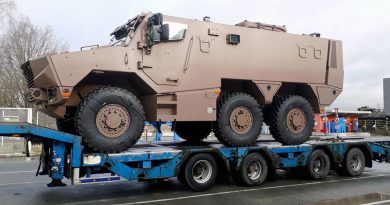Eurosatory 2024 – Drailer, the Arquus multi-mission ground robot
After several developments in the unmanned ground vehicles (UGVs) domain, Arquus is unveiling at Eurosatory 2024 the Drailer, a multi-mission ground robotic platform that can be used as a mine-clearing, fire support or logistic asset, among other uses
Developed from a commercial vehicle already in service with French Special Forces, the Drailer proposed by Arquus is a 1,700 kg 4×4 vehicle with a 2 metres wheelbase, all steering wheels and independent suspensions, which can reach a speed of 40 km/h. The 100 V electric motor has a 76 kW output, on-board energy being provided by a 14 kWh Li-Ion battery pack that ensures a range of around 100 km at 20 km/h. This is doubled installing a 3 kW diesel range extender. The Drailer can overcome a gradient of over 50% and can travel on a side slope in excess of 30%, depending on the payload installed.
The Arquus UGV has a 700 kg payload, the platform being able to provide up to 2 kW electric power to the payload. The Drailer ensures a 12-hour silent watch time, which can be doubled if the range extender is installed. The flatbed is 2,450 mm long and 1,600 mm wide, and can accept a range of payloads, from direct or indirect fire systems such as remotely controlled weapon stations up to 12.7×99 mm machine guns or 40 mm automatic grenade launchers, to antitank missiles such as the MBDA Akeron MP, to 81 mm mortar (deployed on the ground by a hydraulic system), or very-short-range air defence missiles. Other non-kinetic effectors such as electronic warfare packages or counter-UAS systems can also be installed. Arquus is also developing a mine clearing version that is being proposed to the French DGA for the Robin project, aimed at replacing the few Buffalos currently in service with the 13th Engineer Regiment. It is to note that Arquus is not planning to use its Drailer as a reconnaissance asset, the company considering that unmanned air systems provide a cheaper, quicker, and more effective solution.
The Drailer is designed to be towed behind a vehicle at 90 km/h, 90% of the French Armée de Terre vehicles being capable to operate in conjunction with the robot. In the case of infantry support, once the manned vehicle reaches the deployment area, the Drailer is unhooked and starts its autonomous mission in support of the infantry group, the aim being to provide it with a protection bubble.
The robot can be teleoperated beyond line of sight, depending on terrain and the type of radio installed; it is to note that the Arquus UGV features two structures on each side of the flatbed, at the rear, which host the antennas in a raised position that increases range. The operational system software is based on an open architecture that allows easy integration of autonomy modules without the need to modify the base software, which permits a spiral increase in autonomy. Arquus underlines that the Drailer features a dynamic evolution domain protection, meaning that the robot itself will overrun a human command that might endanger the robot itself. The company told EDR On-Line that it is working on a human-machine interface based on the effort done on the joystick rather than on the position, as the human body operates with much better accuracy on effort rather than on position feeling. Another issue is the lack of depth of view due to the two-dimensional vision, which requires to add trajectory elements to help the operator.
The Drailer main sensors are LIDAR and cameras, the former being critical as it is an active system emitting radiations. Currently the UGV is capable to operate in different modes, teleoperation, follow-me behind a human being, follow-me behind a vehicle, and waypoint navigation. The next step will be waypoint navigation with full obstacle avoidance, the final target being full autonomy, something Arquus considers obtainable in 5-6 years.
In the teleoperation mode the company considers the Drailer at TRL 7, which means system prototype in operational environment. Discussions with the STAT, the French Army Technical Service, took place before the exhibition and should lead to first tests in September-October 2024, Arquus looking forward to getting feedback from users’ tests in order to be able to bring a fully developed product at Eurosatory 2026. In Q2 2025 a test is planned with an 8-missile launcher for MBDA Akeron LP missiles.
Photos by P. Valpolini







